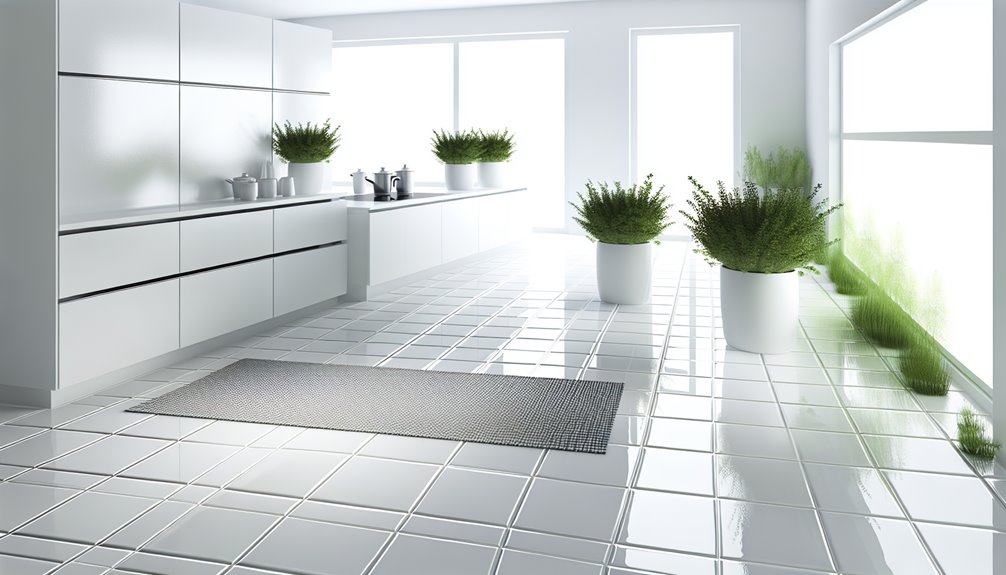When selecting floor tiles for a white interior kitchen, several factors are essential. Color coordination is important; deep blues or rich greens can create striking accents, while soft grays and warm beiges offer a calming atmosphere. Texture plays a key role, combining matte and glossy finishes. Durability guarantees longevity in high-traffic areas, while maintenance routines preserve tile appearance. Finally, the choice of tile size and layout can greatly influence the overall ambiance. More insights await on how to perfect your design.
Key Takeaways
- Choose deep blue or rich green accents to complement the white kitchen and create an inviting atmosphere.
- Opt for a combination of matte and glossy tile finishes to enhance texture and visual interest.
- Prioritize high scratch and moisture resistance in tiles to ensure durability in high-traffic areas.
- Maintain tile appearance with regular cleaning routines and annual resealing if necessary.
- Select larger tiles for a seamless look or smaller tiles for added texture, considering layout patterns for visual appeal.
Color Coordination With White Cabinets and Surfaces
When designing a kitchen with white cabinets and surfaces, effective color coordination becomes essential to create a harmonious aesthetic. The use of contrasting colors can add visual interest, making the space feel vibrant and dynamic.
For instance, deep blues or rich greens can serve as striking accents against the pristine white backdrop. Additionally, incorporating complementary hues, such as soft grays or warm beiges, can enhance the overall design while maintaining a calming atmosphere.
These colors work well to balance the brightness of white, ensuring that the kitchen feels inviting rather than stark. Ultimately, careful selection of floor tiles in these colors can further unify the kitchen’s design, creating a cohesive and appealing environment for cooking and entertaining.
Texture Options for Added Depth and Interest
Incorporating texture into a kitchen design enhances the visual and tactile experience, especially when paired with white cabinets and surfaces.
One effective approach is to combine matte finishes and glossy surfaces in floor tiles. Matte tiles offer a subtle, understated elegance, providing a warm contrast to the sleekness of glossy tiles. This interplay creates a dynamic environment, drawing the eye and adding depth to the overall design.
For instance, a matte finish on the main flooring can ground the space, while glossy accents can be used in specific areas to highlight features such as islands or connecting spaces.
Durability for High-Traffic Areas
Durability is an essential factor to evaluate for floor tiles in high-traffic kitchen areas, where constant foot activity can lead to wear and tear.
Choosing tiles with high scratch resistance guarantees that the surface remains intact despite daily use, preventing unsightly marks and prolonging the aesthetic appeal.
Additionally, moisture resistance is critical in kitchens, as spills and humidity can compromise less durable materials.
Tiles designed to withstand moisture not only resist stains but also reduce the risk of mold growth, contributing to a healthier environment.
Thus, selecting floor tiles that combine both scratch and moisture resistance is fundamental for maintaining the longevity and functionality of a white interior kitchen, making sure it remains stylish and practical for years to come.
Maintenance Considerations for Everyday Use
Selecting the right floor tiles for a white interior kitchen involves not only durability but also ongoing maintenance to secure they remain in peak condition. Regular cleaning routines are essential to preserve the tiles’ appearance and functionality. Stain resistance plays a vital role in maintaining the kitchen’s aesthetic, especially in a white-themed space where spills are more noticeable.
| Maintenance Task | Frequency |
|---|---|
| Sweep or vacuum | Daily |
| Mop with mild cleaner | Weekly |
| Deep clean (steam) | Monthly |
| Reseal (if applicable) | Annually |
Understanding these maintenance considerations will help guarantee the longevity and beauty of the floor tiles, contributing to a functional and attractive kitchen environment.
Choosing the Right Tile Size and Layout
How does the choice of tile size and layout impact the overall aesthetic of a white interior kitchen?
The selection of tile scale greatly influences the perception of space and light. Larger tiles can create a seamless look, amplifying the airy feel of a white kitchen, while smaller tiles can add texture and detail, making the space feel cozier.
Additionally, layout patterns, such as herringbone or staggered arrangements, can introduce visual interest and enhance the kitchen’s design. A well-considered combination of tile size and layout not only complements the cabinetry and countertops but also contributes to a harmonious and inviting atmosphere.
Ultimately, these choices shape the kitchen’s ambiance, leading to a more cohesive and pleasing environment.



